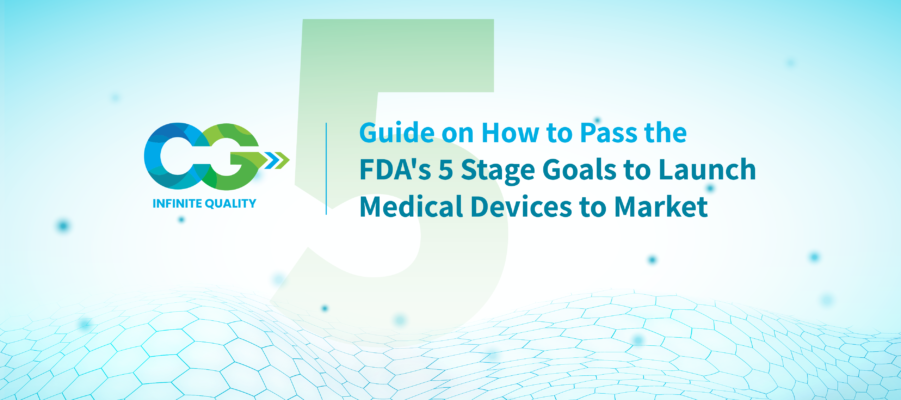Guide on How to Pass the FDA’s 5 Stage Goals to Launch Medical Devices to Market

Article Context:
Bringing medical devices to market is a highly complex, challenging, and regulated process. Medical device manufacturers bear the responsibility of ensuring the safety and effectiveness of their products throughout the entire product’s lifecycle. The Food and Drug Administration (FDA) recently outlined a recommended five-stage process for launching medical devices to the market. These stages are designed to maximize the safety and efficacy of the medical device, from pre-market trials through post-market surveillance and end of life. Often, these steps may intersect as engineers invent, refine, and evaluate the devices. Each stage serves a unique purpose in assessing device quality, efficacy, and safety.
Device Discovery and Concept
In any industry, you need to have an issue to solve before you can think of a solution for the market; this is especially true in the medical device space. You might be beginning from scratch, addressing a medical problem for which there is no known cure or you might also be working to improve the affordability and/or efficiency of current technology. Think about user demands, existing technology, medical issues, and available treatments during the concept phase. The more upfront work the team can do with market research, the better.
It is also important to know how devices are classified as the entire device development process varies on the device's classification. FDA classifies medical devices based on the level of risk they pose to the patients: Class I, Class II, and Class III. The initial classification can change based on the scientific data and evidence available. Class I devices are subjected to general controls such as cGMP (Good Manufacturing Practices), device registration and general recordkeeping requirements. Class II devices are subjected to special controls in addition to general controls; these include device labelling, performance standards and specific testing requirements.
Class III devices typically include medical devices that provide life support or sustenance, are designed to be implanted in the body, or have the potential to pose significant risk of illness or injury. Examples of such devices include HIV diagnostic tests, pacemakers, and breast implants. Due to the potential risks associated, Class III devices require PMA (premarket approval), which necessitates device manufacturers to demonstrate the safety, quality, and effectiveness of the device. Class III devices are also subject to general controls, ensuring compliance with regulatory requirements and standards.
Having a brilliant product idea is not enough to ensure its success; pre-clinical research on the patient population and market is vital to an effective launch. In addition, a critical aspect of device development is defining and planning out the project schedule. Defining the purpose and intended use of the device by conducting thorough analysis of user needs, market demand and regulatory requirements will help outline the scope of the product/project. Often during the concept phase, the new device ideas are not practical. Based on early feasibility, many projects may or may not advance to later phases.
Preclinical Research - Prototype
Another key aspect to progressing towards clinical use is creating and iterating on the prototype to freeze the requirements and design. This stage will help translate the user needs from the concept phase into design inputs and design concepts. This will lead to a strong baseline for design specifications and documentation. In addition, the risk management activities for risk assessment and evaluation will be created and evaluated. As the organization continues to learn more about the product's potential use and effectiveness, they also learn ways to build in risk mitigations to lower the risk of injury within the design, use and functionality of the product. The phase will conclude with all the necessary verification and validation (V&V) activities for the product to show safety, usability and performance of the product are met.
Pathway to Approval
If Design Verification Testing is the dress rehearsal, the clinical evaluation stage is the main event for proving the efficacy of your product. The purpose of this phase is to gather and analyze clinical data for assessing the safety, performance, and effectiveness of the device in real-world clinical settings. Clinical data is collected through methods such as clinical trials, non-clinical testing, and literature reviews and its requirements are dependent on the classification of the device. Ethical considerations, including informed consent and patient privacy, are essential during data collection. The data is then analyzed using statistical methods to draw meaningful conclusions. The findings are compiled into a Clinical Evaluation Report (CER) summarizing clinical evidence supporting the device. Regulatory authorities provide guidelines and requirements for clinical evaluation, and compliance is crucial for obtaining regulatory clearance or approval.
FDA Review
Once medical device developers have gathered sufficient information on the safety and effectiveness of a device, they can proceed to file an application for marketing the device to the public. The type of application they submit depends on the device's classification.
For devices falling under the category of Humanitarian Use Devices, designed to treat or diagnose a disease or condition affecting fewer than 4,000 individuals, developers must file a Humanitarian Device Exemption (HDE) application. This application requires a demonstration that there are no legally approved devices on the market offering similar benefits and that there is no alternative method to bring the Humanitarian Use Device to market.
In the case of most Class I and Class II devices, developers need to submit a Premarket Notification, commonly referred to as a 510(k) application. This application indicates that the Class II device is similar to existing technology available already in the market. To support this claim, developers compare the new device to one or more legally marketed devices that serve as a predicate.
For Class III devices, a Premarket Approval (PMA) application must be submitted. This comprehensive application includes data from both nonclinical and clinical studies. Additionally, during the approval process, the FDA conducts inspections of the manufacturing laboratories and facilities where the device will be produced to ensure compliance with good manufacturing practices. In some cases, FDA may consult an Advisory Committee comprised of independent experts in a relevant field. These committees provide the FDA with unbiased advice and recommendations regarding the approval of the product. Following the Advisory Committee meeting, the FDA decides on whether to approve the device, request additional information, or deem it not approvable. As required by law, the FDA publishes its decision along with all supporting evidence in the Federal Register.
Production and FDA Post-Market Surveillance Monitoring
Production and post-market surveillance are integral components of the medical device lifecycle that ensure the device's ongoing quality, safety, and effectiveness once it reaches the market.
During the production phase, manufacturers establish manufacturing processes and quality control systems to ensure consistent production of the medical device. This involves setting up facilities, implementing production work instructions, and adhering to cGMPs (good manufacturing practices). Key activities include procuring raw materials and components from approved suppliers, conducting inspections and quality checks throughout the production process, performing equipment qualification and process validation, implementing quality assurance measures, and ensuring appropriate labelling, packaging and sterilization.
Post-market surveillance involves monitoring and assessing the device's performance, safety, and effectiveness after it is on the market. This phase aims to identify and address any potential issues that may arise during real-world use, ensuring ongoing patient safety and product improvement. Key activities include monitoring adverse events, complaints, and user feedback, conducting post-market studies or surveys, analyzing data to identify trends or potential risks, implementing corrective and preventive actions, fulfilling reporting obligations, participating in surveillance programs initiated by regulatory authorities, and continuously monitoring scientific literature for new safety information.
The production and post-market surveillance phases are critical for maintaining product quality, identifying potential issues, and ensuring compliance with regulatory requirements. Robust quality management systems are necessary to promptly address concerns, continuously improve the device based on feedback and real-world data and uphold patient safety and satisfaction.
Conclusion
Launching a medical device to market involves a systematic and meticulous process, guided by the FDA's five-stage goals. From concept development to production and post-market surveillance, each stage plays a vital role in ensuring the safety and effectiveness of medical devices. By following these stages and employing appropriate scientific techniques, medical device companies can navigate the regulatory landscape and successfully launch their products.
(Source: FDA)
FAQ's
How to get FDA approval for medical devices?
To get FDA approval for your medical device, you must understand the regulatory pathway. Determining the device classification and working with a strong regulatory team that understands the landscape is critical. As you are developing and designing your device, ensure that the processes you are using align with the FDA compliance expectations in 21 CFR Part 820.
How to get FDA clearance?
- Determine Classification and Regulatory Pathway
- Perform Design Verification and Validation (including Clinical Trials as required)
- Prepare necessary submission documentation (e.g. PMA, 510k, De Novo Request etc.)
- Submit application and await FDA review
- Commercialize product, perform Post-Clearance Activities
AUTHOR:
DAVID DELUCA
Director, Engineering & Validation

